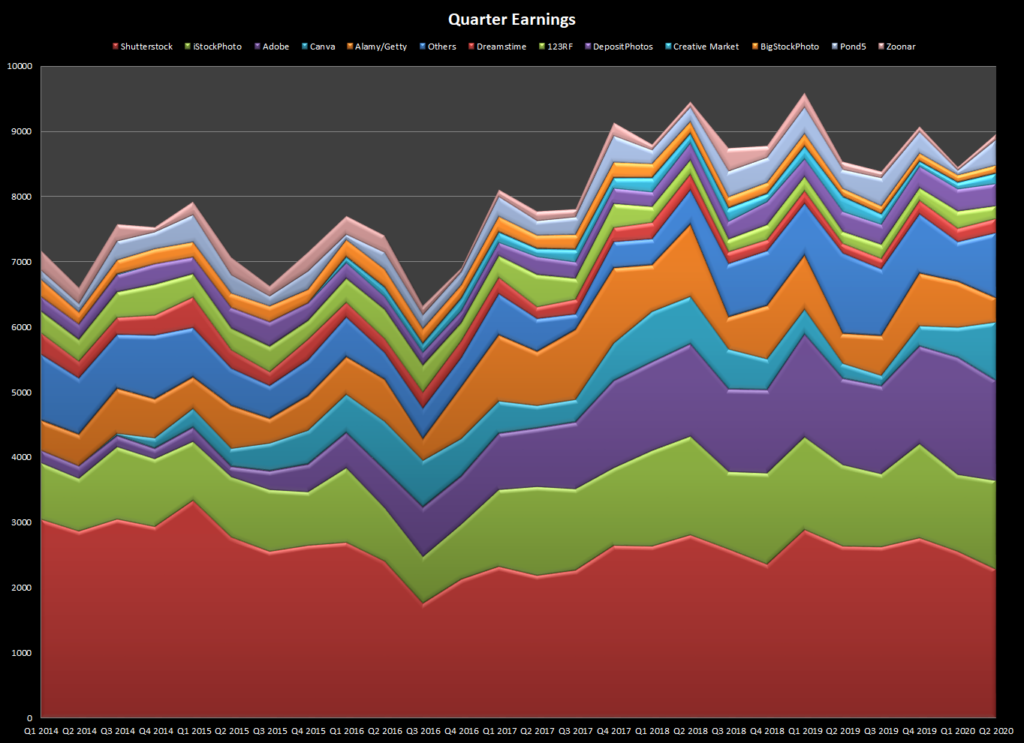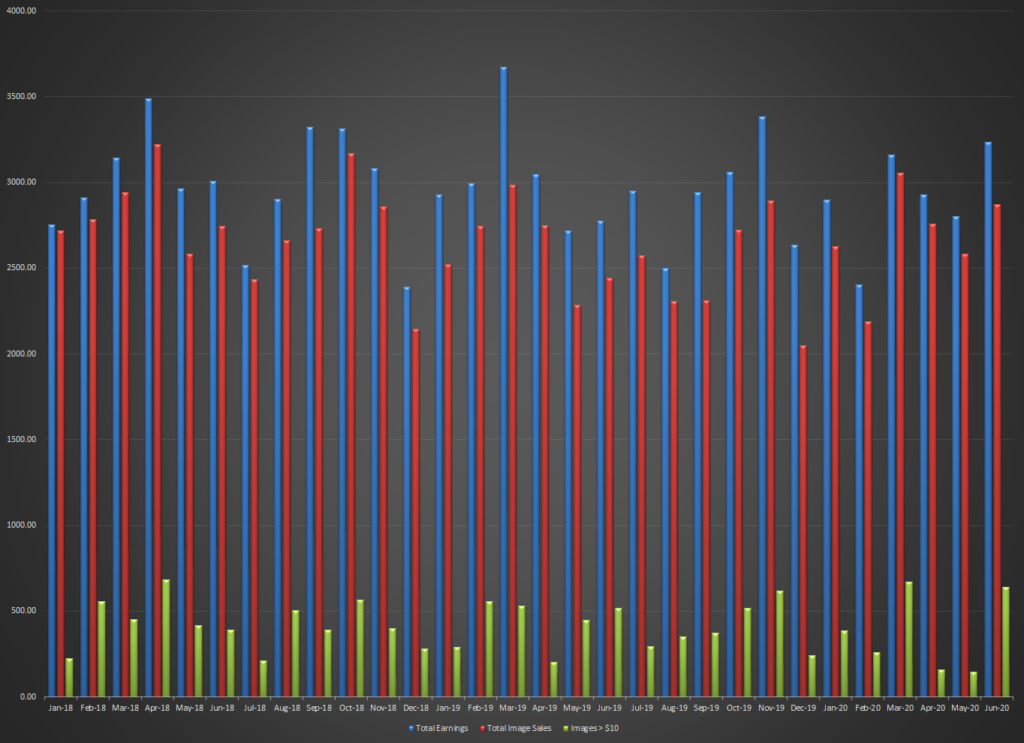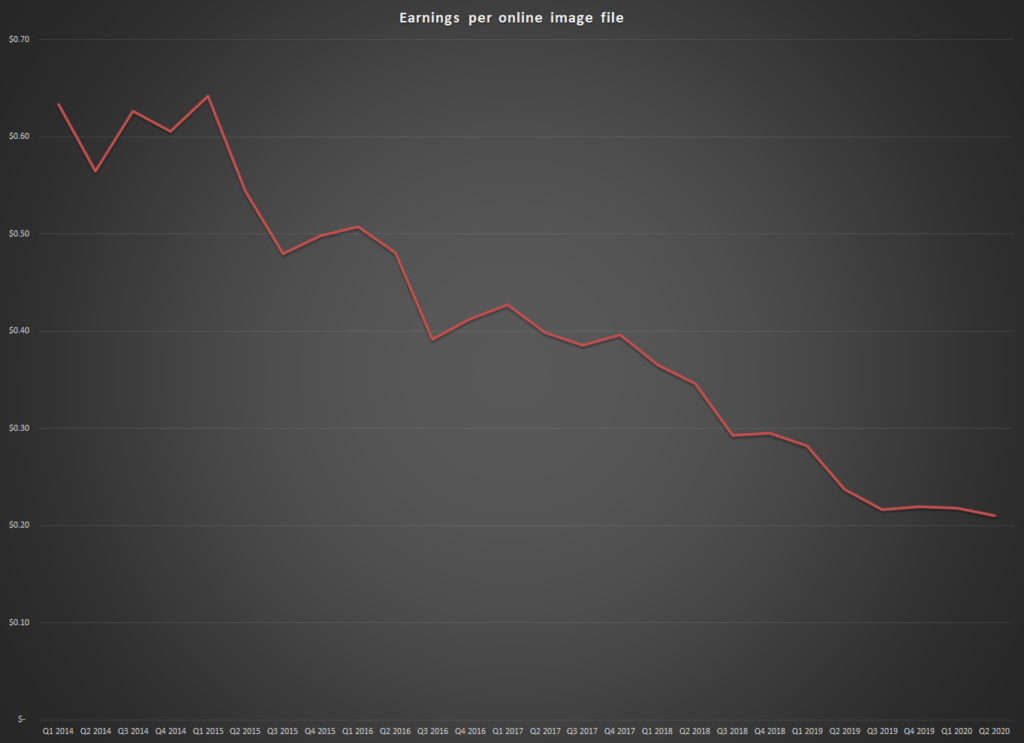Quarterly review of stock photo earnings
Each quarter I do a slightly deeper analysis of my earnings from selling stock photos and videos online and so the quarter 2 results are in. Overall, the quarter from March to June 2020 was not too bad – ending with $8966 of which $755 came from video sales. Q1 of 2020 was slightly lower at $8458. The historical picture is here:

What is interesting about this graph is how the last 3 years have been “reasonably” stable. The end of 2017 represented the end of my growth period when adding new images and videos seemed to result in an increase in earnings, and since then I have averaged just less than $9000 a quarter even though I have continued to add new assets month by month. So the game changed from one where you worked at this to increase your income to a new model where you work each month to keep your income the same. We all know why this is – the earnings per image have been going down. I’m sure this is partly to do with the competition between all the contributors as it became easier to take and upload photos and videos, but it was also driven by the competition between agencies to attract the relatively fixed number of buyers by offering lower prices and bundles of subscriptions that ended up with the contributors being paid less for the same asset. Finally, free stock sites have grown significantly which further attacks the income.
Closer to a monthly salary
This heading is a little tongue in cheek, because I am pretty sure that my income from stock would stay reasonably consistent for at least a year or two if I stopped uploading. Just how long that would last and how quickly it would decline is difficult to predict. So this isn’t really the same as just being paid a monthly salary for doing “work” where the work is the act of taking, keywording and uploading new images. We are still creating something more akin to an annuity where you put in the effort and then receive future payments based on that effort, but it is nothing like as clear as it was a few years ago.
The value of diversity
What is also very clear from the chart is why just supporting one agency (or even two or three) is such a bad idea. As I have said before, I was amazed in reading the comments on the Shutterstock forum from contributors who were asking where else they could submit their images and was Adobe Stock a good idea? Just one glance at the chart shows that there is now no one agency that provides more than 25% of my income. Back in 2014, one agency provided over 40% of my income. So contributing more widely using tools such as Stock Submitter to make uploading to 15 agencies as simple as uploading to just one makes a tremendous difference to my monthly income. It also shows how relatively small agencies can become significant when they are totaled together. So don’t ignore the agencies that perhaps provide just $20 or $40 a month. I don’t believe that many people search among agencies for just the right image – I think most just look at their favorite agency and license an image from there. There is so much choice that they rarely need to shop around. So if you aren’t on 123RF, and someone with an account there needs an image, the you won’t get that sale. That is also why I accept earnings of 10c. I don’t feel this values my work in any way. I just focus on the monthly income and concentrate on how I can improve that over time.
Do large image sales make a difference?
I had a question in my mind recently about the impact that the higher value sales make on overall monthly earnings, so I created a chart to look for any trends! That chart is below and shows total earnings in a month, earnings from image sales and finally, how much was made from images that sold for more than $10. The difference between the first two columns is the income from video sales.

The answer that comes from the chart is perhaps not as clear as I hoped it would be. Yes, there is a bit of a correlation between a higher volume of > $10 sales but it doesn’t seem to be a big driver of overall sales. It is that steady drip of all those smaller value sales that really makes the majority of my income. I do like seeing a sale which nets $100, but I guess the message is that getting a regular number of downloads each day is actually more important.
What about earnings per image?
I also use this quarterly review to look at my return on effort. Some people get obsessed with earnings per download, but I have been more concerned about how much my portfolio has been earning. So if I add a new image to my portfolio, how much is it likely to earn for me. That is what I calculate in my earnings per online image. The calculation is relatively simple – I average the number of files on Shutterstock, Adobe Stock and iStock each quarter and divide that into my total earnings from all agencies. The really accurate way would be to track files per agency, but I don’t want to spend all the time to do that! This graph has been falling like a stone over the past few years, which explains why my income hasn’t increased even though I regularly add new files:

Frightening! From an average of $0.60 per online image per month in 2014, this has fallen quarter by quarter as though it would hit zero in a couple of years! This is the main reason why my earnings are static, month by month. Now, why is this? I think this is partly to do with all the reasons above – more competition and lower prices, but it is also impacted by me taking more images on my travel adventures (including editorial ones) and uploading more variety from each trip. So you could say that the total number of images that are licensed that show Kauai is relatively fixed because buyers only have a relatively stable need for such images. With RF licenses, they can also reuse images they licensed in previous years as well. So if I add another 100 images from Kauai, I am increasing my portfolio, but sharing the fixed spend among more images. Of course, if my images get better, then I am more likely to increase my share of that spend, but I hope you get the picture. I’m sure others are adding more Kauai images as well. Occasionally a totally new subject comes along – the coronavirus – and there are few images available to meet that need, so the income can actually rise.
The good news in this graph is that the last 4 quarters have levelled off! No longer is it falling like a stone! Will this last, is this the start of a new trend? Time will tell!







Hi Steve,
I look forward to your posts, always an interesting read. Two questions if I may.
I currently upload images at 3600 px on the longest side. Is this sufficient do you think?
Also, I currently upload to 10 sites individually and now have almost 10,000 images on SS (less on others). Do you think it would be worthwhile to add more sites using Stock Submitter, for which I’d have to pay?
Thanks for your time…….Michele
Hi Michele
Thanks for your kind comments! I used to upload at 4500px but now it tends to be 5000 – 5500px. The only reason I do that is that some sites (Shutterstock for instance) displays the pixel size and there is always a chance that someone who doesn’t really know what they are doing will think – well the bigger file must be better! They don’t know that any file of this size is suitable for pretty much any use, but with two to choose from, they might pick the larger one. I don’t know if that is true, but it sort of seems possible!
There is a free tier on Stock Submitter of 33 submissions a month so you might try that. Also, you can buy a certain tier for one month and upload a lot in that month and then go down to a smaller or the free one. So you could maybe upload a lot of files to a few more agencies in one go, for not much money. Just an idea!
Steve
Hi Steve. Fascinating info. I’m curious if you would let us know how many images and how many clips you had available for purchase (at any and all agencies) for Q2. Thank you!
Mark
Hi Mark – Yes. I reported on my portfolio size most recently in this post.
Steve
Hi Steve, a really interesting post and thank you for sharing. I strongly believe in avoiding the exclusive option and I’m happy that an expert microstock photographer like you is in line with this opinion.
Hi Paolo
Yes, I have always been against exclusive approaches. It is too difficult to foresee how the industry will evolve. I can see how it made sense in the early days of iStock perhaps when there was a clear leader but it would be interesting (although difficult to calculate) if those people would have been better off as non-exclusive across multiple agencies.
Steve